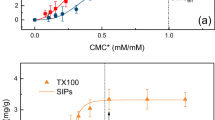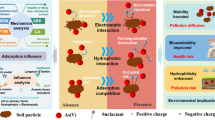Abstract
Polyether trisiloxane surfactants are widespread used as agricultural adjuvants because they increase the activity and the rainfastness of pesticides. On the contrary to pesticides, the environmental fate of agricultural adjuvants has not been much investigated, yet. Especially for trisiloxane surfactants, the knowledge on their environmental fate is scarce. To fill this gap, the mobility of a polyether trisiloxane surfactant on soil was studied. With a sorption batch equilibrium method, distribution coefficients between water and soil (K d, K oc, and K clay) were estimated for two standard soils (loam and sandy loam) and for every homologue of the trisiloxane surfactant. The obtained values for K d were between 15 and 135 cm3 g−1, indicating that the trisiloxane surfactant is only slightly mobile in soil. The leaching in soil column was studied in a worst case scenario where the application of the trisiloxane surfactant was done on quartz sand and was immediately followed by a heavy rainfall. Less than 0.01 % of the initially applied trisiloxane surfactant had leached through 20 cm of quartz sand. Based on the K d values and the leaching in a soil column, the studied trisiloxane surfactant seems to be unlikely to leach through soil after application as agricultural adjuvant.






Similar content being viewed by others
References
Bonnington, L. S. (2000). Analysis of organosilicone surfactants and their degradation products. Ph.D. thesis, University of Waikato, New Zealand.
Cornejo, J., Jamet, P., & Mansour, M. (2000). Pesticide/soil interactions: some current research methods. Paris: Institut national de la recherche agronomique.
Food and Agriculture Organization of the United Nations. (2000). FAO Pesticide Disposal Series 8, Assessing soil contamination: a reference manual. http://www.fao.org/fileadmin/templates/agphome/documents/Pests_Pesticides/Obsolete/Assessing_contamination_-_A_reference_manual.pdf, Accessed 8 December 2015.
Griessbach, E. F. C., Copin, A., Deleu, R., & Dreze, P. (1997). Mobility of a siliconepolyether studied by adsorption and desorption isotherms and soil thin-layer chromatography. Science of the Total Environment, 201, 89–98.
Griessbach, E. F. C., Copin, A., Deleu, R., & Dreze, P. (1998). Mobility of a siliconepolyether studied by leaching experiments through disturbed and undisturbed soil columns. Science of the Total Environment, 221, 159–169.
Knoche, M., Tamura, H., & Bukovac, M. J. (1991). Performance and stability of the organosilicone surfactant L-77: effects of pH, concentration, and temperature. Journal of Agricultural and Food Chemistry, 39, 202–206.
Krogh, K. A., Halling-Sörensen, B., Mogensen, B. B., & Vejrup, K. V. (2003). Environmental properties and effects of nonionic surfactant adjuvants in pesticides: a review. Chemosphere, 50, 871–901.
Laegdsmand, M., Moldrup, P., & De Jonge, L. W. (2007). Modelling of colloid leaching from unsaturated, aggregated soil. European Journal of Soil Science, 58, 692–703.
Lange, F. T., & Michel, A. (2015). Bedeutung von Silikontensiden für die Wasserversorgung. DVGW Energie Wasser-Praxis, 03, 56–62.
Lara-Martín, P. A., Gómez-Parra, A., & González-Mazo, E. (2008). Reactivity and fate of synthetic surfactants in aquatic environments. TrAC Trends in Analytical Chemistry, 27, 684–695.
Michel, A., Brauch, H.-J., Worch, E., & Lange, F. T. (2012). Development of a liquid chromatography tandem mass spectrometry method for trace analysis of trisiloxane surfactants in the aqueous environment: an alternative strategy for quantification of ethoxylated surfactants. Journal of Chromatography A, 1245, 46–54.
Michel, A., Brauch, H.-J., Worch, E., & Lange, F. T. (2014). Homologue specific analysis of a polyether trisiloxane surfactant in German surface waters and study on its hydrolysis. Environmental Pollution, 186, 126–135.
Navarro, S., Vela, N., & Navarro, G. (2007). Review. An overview on the environmental behaviour of pesticide residues in soils. Spanish Journal of Agricultural Research, 5, 357–375.
Organisation for Economic Co-operation and Development. (2000). OECD guideline for the testing of chemicals: adsorption - desorption using a batch equilibrium method. Resource document. http://www.oecd-ilibrary.org/docserver/download/9710601e.pdf?expires=1381145969&id=id&accname=guest&checksum=5B06EEC083852D5BA81BBA88A66257BD Accessed 29 October 2013.
Penner, D., Burow, R., & Roggenbuck, F. C. (1999). Use of organosilicone surfactants as agrichemical adjuvants. In R. M. Hill (Ed.), Silicone surfactants (pp. 241–258). New York: Marcel Dekker.
Robertson, W. D., Van Stempvoort, D. R., Solomon, D. K., Homewood, J., Brown, S. J., Spoelstra, J., & Schiff, S. L. (2013). Persistence of artificial sweeteners in a 15-year-old septic system plume. Journal of Hydrology, 477, 43–54.
United States Department of Agriculture, Natural Resources Conservation Service. (2013). Soil survey manual. Resource document. http://www.nrcs.usda.gov/wps/portal/nrcs/detail/soils/ref/?cid=nrcs142p2_054253. Accessed 8 December 2015.
Van Stempvoort, D. R., Roy, J. W., Brown, S. J., & Bickerton, G. (2011a). Artificial sweeteners as potential tracers in groundwater in urban environments. Journal of Hydrology, 401, 126–133.
Van Stempvoort, D. R., Robertson, W. D., & Brown, S. J. (2011b). Artificial sweeteners in a large septic plume. Ground Water Monitoring Remediation, 31, 95–102.
Venzmer, J. (2011). Superspreading—20 years of physicochemical research. Current Opinion in Colloid and Interface Science, 16, 335–343.
Acknowledgments
This work was financially supported by the German Association for Gas and Water, a registered technical-scientific association (Deutscher Verein des Gas- und Wasserfaches e.V. DVGW), project W 2-01-10. We are grateful to CHT R. Beitlich GmbH for the cooperation and for providing HANSA ADD 1055 for the soil column experiments. We thank Dr. Oliver Happel for the picture of superspreading and Dr. Florian Storck for the fruitful discussions during the elaboration of this manuscript.
Author information
Authors and Affiliations
Corresponding author
Electronic supplementary material
Below is the link to the electronic supplementary material.
ESM 1
(DOC 559 kb)
Rights and permissions
About this article
Cite this article
Michel, A., Dietschweiler, C., Böni, M. et al. Mobility of a Polyether Trisiloxane Surfactant in Soil: Soil/Water Distribution Coefficients and Leaching in a Soil Column. Water Air Soil Pollut 227, 66 (2016). https://doi.org/10.1007/s11270-016-2755-9
Received:
Accepted:
Published:
DOI: https://doi.org/10.1007/s11270-016-2755-9




